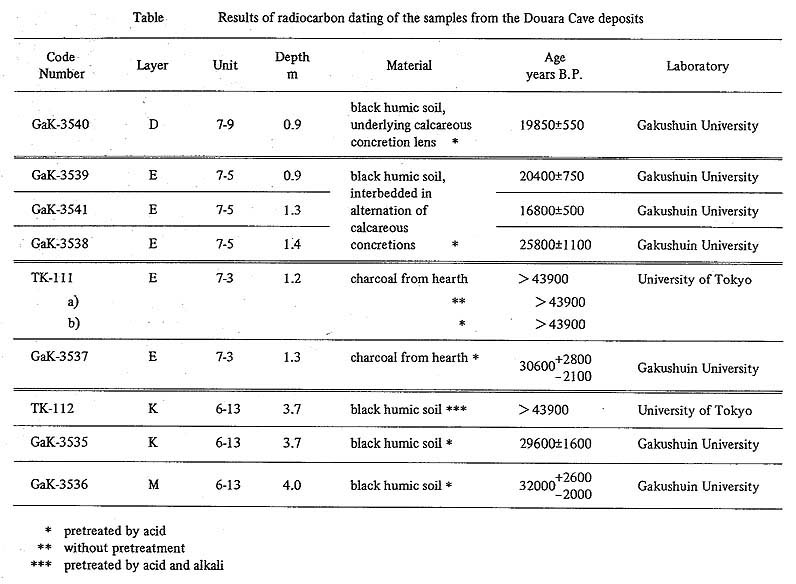APPENDIX III COMMENTS ON THE RADIOCARBON DATING OF THE DOUARA CAVE DEPOSITS
Kunihiko ENDO
Department of Geography, Faculty of Science, The University of Tokyo
|
Nine samples (charcoals or humic soils) for radiocarbon dating were taken from Layers D, E, K and M. Dating was carried out by the Radiocarbon Dating Laboratories of Gakushuin University and the University of Tokyo. These results and the stratigraphic location of each smaple are shown in the Table and Figure . Samples GaK-3539, GaK-3541, GaK-3538 were taken from thin, humic beds between the alternations of whitish calcareous concretion lenses of the first type in Layer E. Samples GaK-3537 and TK-111 are powdered charcoal taken from the hearth interbedded in the ash lens of the lower part of Layer E (PI. 11-5). Samples GaK-3535, TK-112 and GaK-3536 were taken from Layers K and M, the two layers of black humic soil in the deepest part of the excavation. Two sets of samples, GaK-3537 - TK-111 and GaK-3535 -TK-112, may be used for cross-check of the results from different laboratories. GaK-3535 and TK-112 were both obtained from black humic soil of Layer K, where TK-112 is 5 cm upper than GaK-3535. GaK-3537 and TK-111, collected in the same lens of charcoal, are separated each other 10 cm vertically and 20 cm laterally as shown in Figure. There are remarkable discrepancies among the dates obtained and the stratigraphic relationships of these samples. Moreover, many dates differ from the age of 45,000 -40,000 B.P., estimated from the Levalloiso-Mousterian industries found in Layers D and E. The ages for samples GaK-3539, 3541, 3538 and 3540 are considerably younger than for sample GaK-3537, although all these samples are taken from about the same stratum (Layer E and the base of layer D). Samples GaK-3539 and GaK-3541 even gave stratigraphically reversed dates. These four samples were collected from humic soil intercalated between clacareous concretion beds or found in calcareous concretion lenses. On the other hand, there is no calcareous concretions around the point where GaK-3537 and TK-111 were obtained. Sample TK-111 was rechecked for the possibility of contamination of carbonate carbon by two measurements, one is pretreated with acid and another without pretreatment. The same date was, however, obtained. This fact seems to preclude the possibility of contamination by carbonate carbon. This means that these four samples might have been affected by dripping or flowing water which contains the older carbonate carbons derived from the surrounding limestone. Moreover, the layers from which they derive are very shallow and might have been affected by recent deterioration or contamination of organic carbons.In general, the samples obtained from the beds adjoining to or surrounded by the calcareous concretions show diversified dates. GaK-3535 and GaK-3536 give approximately the same age as that of GaK-3537 which is, however, stratigraphically 2.5 m upper than the former two. Contamination by recent carbon in the materials of the deep samples seems unlikely.
|

